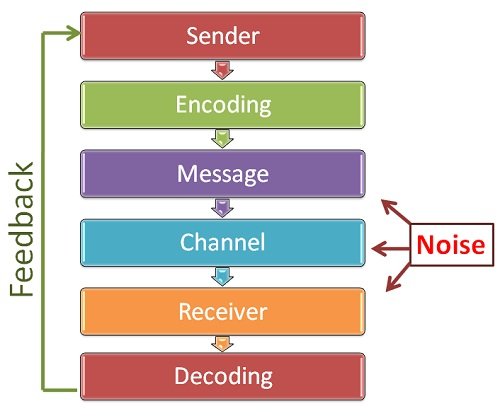Communications is fundamental to the existence and survival of humans as well as to an organization. It is a process of creating and sharing ideas, information, views, facts, feelings, etc. among the people to reach a common understanding. Communication is the key to the Directing function of management.
Concept of Communication
A manager may be highly qualified and skilled but if he does not possess good communication skills, all his ability becomes irrelevant. A manager must communicate his directions effectively to the subordinates to get the work done from them properly.
Communication is simply the act of transferring information from one place, person or group to another.
Every communication involves (at least) one sender, a message and a recipient. This may sound simple, but communication is actually a very complex subject.
The transmission of the message from sender to recipient can be affected by a huge range of things. These include our emotions, the cultural situation, the medium used to communicate, and even our location. The complexity is why good communication skills are considered so desirable by employers around the world: accurate, effective and unambiguous communication is actually extremely hard.
Process of Communications
Communications is a continuous process which mainly involves three elements viz. sender, message, and receiver. The elements involved in the communication process are explained below in detail:

- Sender
The sender or the communicator generates the message and conveys it to the receiver. He is the source and the one who starts the communication
- Message
It is the idea, information, view, fact, feeling, etc. that is generated by the sender and is then intended to be communicated further.
- Encoding
The message generated by the sender is encoded symbolically such as in the form of words, pictures, gestures, etc. before it is being conveyed.
- Media
It is the manner in which the encoded message is transmitted. The message may be transmitted orally or in writing. The medium of communication includes telephone, internet, post, fax, e-mail, etc. The choice of medium is decided by the sender.
- Decoding
It is the process of converting the symbols encoded by the sender. After decoding the message is received by the receiver.
- Receiver
He is the person who is last in the chain and for whom the message was sent by the sender. Once the receiver receives the message and understands it in proper perspective and acts according to the message, only then the purpose of communication is successful.
- Feedback
Once the receiver confirms to the sender that he has received the message and understood it, the process of communication is complete.
- Noise
It refers to any obstruction that is caused by the sender, message or receiver during the process of communication. For example, bad telephone connection, faulty encoding, faulty decoding, inattentive receiver, poor understanding of message due to prejudice or inappropriate gestures, etc.
One thought on “Communication Meaning, Concept and Process”